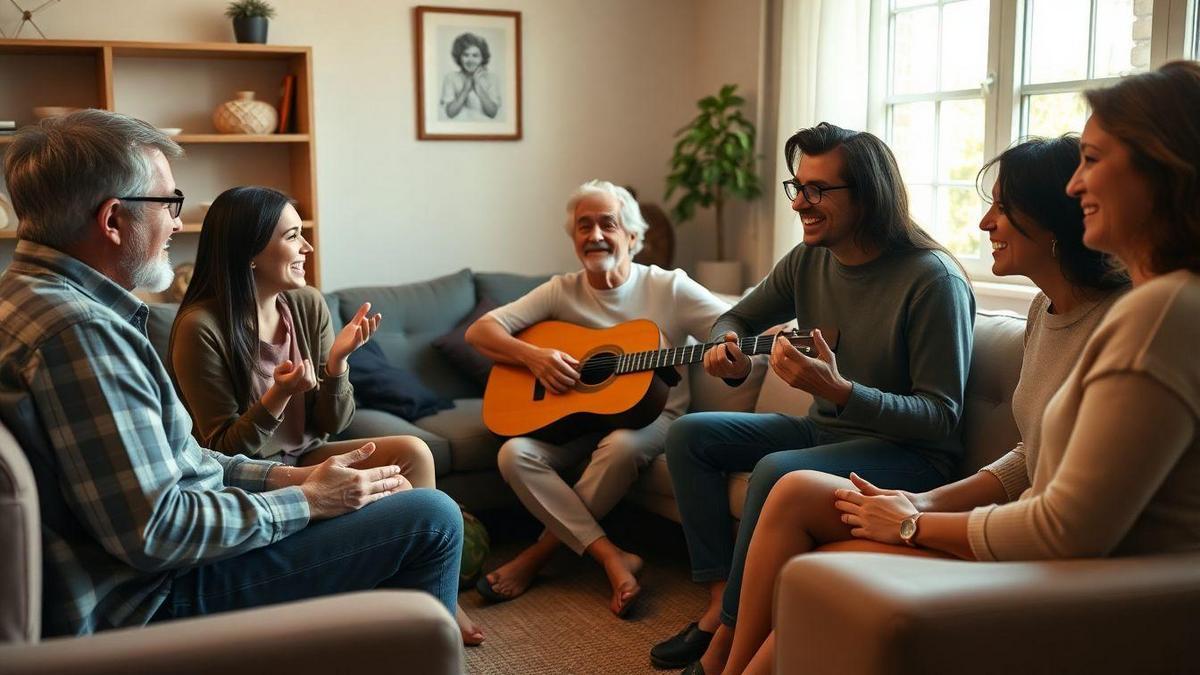How music can boost your confidence
How music can boost your confidence surprised me and changed my mood fast. When nerves feel heavy, an upbeat familiar song loosens me up: my breathing, posture, and thoughts shift — the way a tune ties to past moments can make it feel instantly safe and energizing (how personal memories shape musical comfort). My brain hands out little dopamine rewards that make me want to try again. I build short playlists, use power songs before shows, improvise to take risks, and write tiny lyrics to name my strengths. Those quick, practical steps give real confidence I can use today.
Key takeaway
- Play an upbeat song to lift mood fast.
- Sing along to feel bolder and less shy.
- Use a power song before a performance or meeting.
- Practice with music to calm nerves before tasks.
- Match breathing to the beat to feel steadier.

How music can boost your confidence by changing mood and brain chemistry
How music can boost your confidence is something I tested on myself. Music shifts mood and brain chemicals—dopamine, endorphins—and lowers cortisol (study on dopamine release from music). That mix makes me clearer and braver. A song can wrap a blanket of calm around me or light a fire under my feet, depending on what I pick.
Tempo, key, and familiarity: quick rules
- Tempo: Fast songs raise heart rate and energy; slow songs calm breathing.
- Key: Major keys feel brighter and more confident; minor keys feel reflective — learning how to add emotional detail to notes helps you choose better tracks (how to add emotion to every note).
- Familiar songs: Predictability lowers anxiety and increases comfort.
If I need energy, I pick a steady upbeat tempo. To calm down, I choose a slow, familiar melody. For gentle confidence, I sing along—my voice adds control.
How dopamine and reward circuits respond
- Dopamine spikes at musical peaks; that rush feels like a small reward — the same moments that give us goosebumps can signal meaningful musical reward (why certain songs hit us hard).
- My brain links good feelings to the song, so repeating the song helps build habits and skills.
- Each small musical win—nailing a riff, improvising successfully—encourages more trying, and confidence grows.
I notice small wins stack into real change. That’s one concrete way how music can boost your confidence.
Quick tip: pick an upbeat familiar song (2–4 minutes)
- Choose a known, upbeat track.
- Play it, sing a line, move for one chorus.
- Breathe deep twice and notice the shift.

How I build a confidence-boosting playlist for daily practice
I set one goal: build confidence in small, repeatable steps. Think of the playlist like a workout—warm-up, pushes, cool-down.
- Mix first-person lyrical tracks and instrumentals for focus.
- Keep total time under 30 minutes so it’s easy to repeat—short daily habits beat long rare sessions (the power of just twenty minutes daily). See research on how habits form for evidence.
- Include 1–2 affirmation tracks or short lines you want to learn.
- Remove songs that drag you down, even if they’re popular.
This structure makes daily practice feel natural, not like a chore (making practice feel enjoyable).
Why repetition with music helps
Repetition makes new thoughts stick. Singing a short I can line every morning wires the phrase into your day. Music ties words to emotion, so phrases feel true faster. Short, repeated sections are easier to remember than long speeches.
Example: after a week of singing one confident line each morning, my inner voice shifted. That’s exactly how music can boost your confidence—by wiring positive phrases into daily life.
Best types of songs and a short 10-song playlist
I choose catchy, clear tracks and cycle genres so the brain doesn’t get bored. Types that work:
- Songs with repeatable choruses to sing aloud.
- Instrumental tracks with steady rhythm for focus.
- Upbeat anthems for body movement.
- Calm piano or acoustic pieces for breathing and reflection.
- Short affirmation tracks for habit training.
Sample 10-song confidence playlist (short, repeatable):
- Fight Song — Rachel Platten — sing the chorus for small wins
- Roar — Katy Perry — loud breath and posture practice
- Eye of the Tiger — Survivor — steady rhythm for focus
- Happy — Pharrell Williams — mood reset
- Short affirmation track (2–3 min) — repeat key phrases
- Instrumental ambient piano — calm concentration
- Upbeat funk track — loosen shoulders and voice
- Acoustic confidence song — honest, quiet practice
- Dance/house track — movement and breath control
- Classical crescendo piece — finish strong and reflective
Play as warm-up (5–7 min), two pushes (10–15 min), cool-down (5–7 min). Repeat daily to build muscle memory—for voice and belief. If you want a simple daily structure, try combining this playlist approach with short routines and rituals (rituals that help you enter practice mode) and a modest practice plan (how to create a simple daily practice routine).

How I use power songs to feel confident before a performance
Power songs are like armor. I keep three that flip a switch: grounding, steady, ignite. They sharpen focus, raise energy, and calm nerves. Lyrics that lift, beats that move, and a hook I can hum backstage are the key features.
Pre-show routine (10 minutes)
- Grounding track (2–3 min): slow, calm.
- Steady track (2 min): medium tempo for focus.
- Ignite track (1–2 min): high energy to boost confidence.
After each song: three deep breaths (inhale 4, hold 2, exhale 6). Hum a line on the last exhale to lock it in.
How high-energy tracks change my body
- Posture: I stand taller; chest opens.
- Breathing: breaths deepen and even out.
- Alertness: focus sharpens, details pop.
Small shifts add up fast—music acts like a metronome for the body.
Improvisation, mistakes, and risk-taking
Improvisation taught me to trust my ears and act without a perfect plan. Fumbling my first bars at an open mic led to honest playing that changed me. I started saying yes to surprises; that courage spilled into other parts of life. If you’re new to this, check approaches for beginners that break improv into tiny steps (improvisation made simple for absolute beginners) and demystify playing by ear (what playing by ear really means).
Habits to accept mistakes
- Call mistakes a signal and ask, What can this lead to? — reframing errors is a skill you can practice (how to turn mistakes into learning opportunities).
- Practice in short sessions so stakes stay low.
- Listen more than you play to gather options.
- Name your fear out loud to shrink it.
- Celebrate imperfect moments that lead somewhere fresh.
Simple improv exercises (short bursts)
- Hold one note for two minutes, then move by tiny steps.
- Call-and-response with a friend or recording.
- Limit solos to three notes.
- Rhythm-only solo: clap or tap.
- Trade fours: build trust and timing.
Five-minute improv warm-up
0–1: Breathe and hum one note.
1–2: Vary loudness on the same note.
2–3: Add a second note; keep phrases short.
3–4: Say a word or emotion and play how it sounds.
4–5: Finish with a tiny phrase and repeat with small changes.
That warm-up kills the chilly silence in your chest and primes courage. If fear of starting is holding you back, read simple strategies to begin without pressure (overcoming the fear of starting music).

Songwriting and claiming your voice
Composing gave me a place to claim my voice. Each finished melody felt like a tiny victory and lifted my self-esteem. Writing lyrics forced me to name strengths aloud—persistence, listening, honesty—and that naming made them real.
Easy songwriting steps
- Pick and name the feeling.
- Find one strong hook line.
- Hum a simple melody.
- Freewrite five minutes; pull singable phrases.
- Choose a chord pattern that matches the mood.
- Record a rough take on your phone and listen kindly.
- Tweak one line at a time until it feels honest.
Start with four lines about one proud moment to build esteem. Finishing a draft gives proof you can point to: I did that. If you want a low-pressure path into writing, try a step-by-step guide to beginning melodies (writing your first melody without overthinking) and simple chord explanations to match mood to harmony (what chords are and why they matter). For adding weight to a line, read techniques for expressive phrasing (how to add emotion to every note).

Music and workouts: rhythm as control
When I search How music can boost your confidence I’m often thinking about workouts—how sound can make me feel brave and ready to push harder. Rhythm syncs with motion and builds a sense of control and self-efficacy (NHS summary of music therapy benefits).
- Beat guides pace and breathing.
- Repeating a pattern reduces anxiety.
- Simple rhythms improve focus on form.
BPM guide I use
| BPM range | Feel / use | Example activity |
|---|---|---|
| 60–90 | Calm, warm-up, cooldown | Stretching, yoga |
| 90–115 | Steady, moderate | Easy runs, steady lifts |
| 120–140 | Energized, upbeat | HIIT, tempo runs |
| 140–170 | High-drive, power | Sprints, explosive sets |
Match a song’s BPM to your workout: sync the first minute to the beat, adjust if form drifts. A matched song gives instant focus and momentum.

Music therapy, evidence, and working with a pro
I used music therapy when public speaking made my chest tight. Humming and simple rhythms grew into real confidence. Research backs it: music sessions lower heart rate and stress hormones, improve mood, and help people use music to cope (how music aids stress and mood). If you want structured help, look into how playing and listening can clear the mind and support emotional goals (how playing clears the mind through music therapy).
- Studies show reduced anxiety and improved mood after music sessions (overview of clinical music therapy practice).
- Group music boosts social support and reduces isolation.
- Music gives a safe practice field where mistakes mean learning.
How therapists structure musical confidence goals
- Assessment: identify fears and goals.
- Goal setting: pick small, measurable goals.
- Practice tasks: simple, repeatable exercises.
- Feedback and graduated challenges.
If you want results, ask a licensed music therapist for guided tasks, a short daily plan, and ways to track progress (weekly mood checks or short recordings). I tracked recordings and heard real gains—concrete proof kept me going.

Groups, social settings, and belonging
Music is a bridge when words feel heavy. Singing or playing with others gives low-pressure roles that build confidence. I start small, listen more, and celebrate tiny wins: a clean phrase, steady beat, or a laugh after a rehearsal.
- Join a beginner or all-levels group and go regularly.
- Volunteer for tiny roles first.
- Treat mistakes as clues, not failures.
Choirs, jams, and open mics are practice grounds where audiences are forgiving and supportive—perfect places to learn how music can boost your confidence in social contexts. If you’re nervous about joining, read common beginner pitfalls and how to stay motivated when progress feels slow (seven beginner mistakes that slow progress, staying motivated when progress feels slow).

Quick, instant music hacks I use today
Music is my secret handshake with courage. Short tricks flip my mood fast.
One-song mood reset (90 seconds)
- Pick a short track with a clear tempo.
- Match and slow your breath to the beat.
- Focus on a single line or beat as an anchor.
This can lower stress fast and make your voice feel steady.
My pocket list of clips
- Queen — Don’t Stop Me Now (first 90 sec)
- Katy Perry — Roar (chorus)
- Bill Withers — Lovely Day (intro chorus)
- Survivor — Eye of the Tiger (riff)
- Sia — Unstoppable (hook)
- Beethoven — Ode to Joy (short clip)
- Reggaeton/electronic (30–60 sec beat drop)
- Instrumental piano (60–90 sec calm clip)
90-second pre-meeting ritual
- Queue a 90-second clip you love.
- Stand tall, volume firm but not loud.
- Breathe twice with the first 30 seconds; anchor on the beat.
- Repeat a short mantra once during the chorus (I’ve got this).
- Take one final breath and go in.
That short ritual flips my body from anxious to ready. If procrastination blocks your practice, pairing short rituals with simple tracking helps (how to stop procrastinating on music practice).

Conclusion
I’ve seen firsthand how music can boost your confidence. A 90-second power song, a daily 10–30 minute playlist, a five-minute improv warm-up, and small songwriting wins stack into real change. Music calms the chest, steadies the breath, and hands out tiny dopamine badges that push you forward. Start small: pick a 90-second clip that makes you stand taller, repeat a short playlist daily, and treat mistakes as clues, not cliffs. Music became my mirror and my armor—and it can do the same for you.
For more ideas and practical playlists, visit https://clickneutro.com and explore articles that helped me turn music into a real confidence tool.
